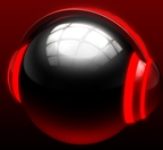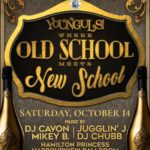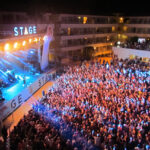Scratching, sometimes referred to as scrubbing, is a DJ and turntablist technique used to produce distinctive percussive or rhythmic sounds and sound effects by moving a vinyl record back and forth on a turntable while optionally manipulating the crossfader on a DJ mixer. While scratching is most commonly associated with hip hop music, where it emerged in the mid-1970s, it has been used in the 1990s and 2000s in some styles of rap rock, rap metal and nu metal. Within hip hop culture, scratching is one of the measures of a DJ’s skills. DJs compete in scratching competitions at the DMC World DJ Championship and IDA (International DJ Association, formerly known as ITF (International Turntablist Federation). At scratching competitions, DJs can use only scratch-oriented gear (turntables, DJ mixer, digital vinyl systems or vinyl records only). In recorded hip hop songs, scratched “hooks” often use portions of other songs.
Vinyl recordings
- Traktor Scratch Pro
- Cross DVS
- Virtual DJ Pro
- Serato Scratch Live
- M-Audio Torq
- Deckadance
Non-vinyl scratching
While some turntablists consider the only true scratching media to be the vinyl disc, there are other ways to scratch, as:
- Specialized DJ-CD players with jog wheels, allowing the DJ to manipulate a CD as if it were a vinyl record, have become widely available in the 2000s.

- Vinyl emulation software allows a DJ to manipulate the playback of digital music files on a computer via a DJ control surface (generally MIDI or a HID controller). DJs can scratch, beatmatch, and perform other turntablist operations that cannot be done with a conventional keyboard and mouse. DJ software performing computer scratch operations include Traktor Pro, Mixxx, Serato Scratch Live & Itch, Virtual DJ, M-Audio Torq, DJay, Deckadance, Cross.
- DJs have also used magnetic tape, such as cassette or reel to reel to both mix and scratch. Tape DJing is rare, but Ruthless Ramsey [13] in the US, Tj Scratchavite [14] in Italy and Mr Tape [15] in Latvia use exclusively tape formats to perform.
Sounds
Sounds that are frequently scratched include but are not limited to drum beats, horn stabs, spoken word samples, and vocals/lyrics from other songs. Any sound recorded to vinyl can be used, and CD players providing a turntable-like interface allow DJs to scratch not only material that was never released on vinyl, but also field recordings and samples from television and movies that have been burned to CD-R. Some DJs and anonymous collectors release 12-inch singles called battle records that include trademark, novel or hard-to-find scratch “fodder” (material). The most recognizable samples used for scratching are the “Ahh” and “Fresh” samples, which originate from the song “Change the Beat” by Fab 5 Freddy.
There are many scratching techniques, which differ in how the movements of the record are combined with opening and closing the crossfader (or another fader or switch, such as a kill switch, where “open” means that the signal is audible, and “closed” means that the signal is inaudible). This terminology is not unique; the following discussion, however, is consistent with the terminology used by DJ QBert on his Do It Yourself Scratching DVD.
Sophisticated techniques
- Baby scratch – The simplest scratch form, it is performed with the scratching hand only, moving the record back and forth in continuous movements while the crossfader is in the open position.
- Forward and backward scratch – The forward scratch, also referred to as scrubbing, is a baby scratch where the crossfader is closed during the backwards movement of the record. If the record is let go instead of being pushed forward it is also called “release scratch”. Cutting out the forward part of the record movement instead of the backward part gives a “backward scratch”.
- Tear scratch – Tear scratches are scratches where the record is moved in a staggered fashion, dividing the forward and backward movement into two or more movements. This allows creating sounds similar to “flare scratches” without use of the crossfader and it allows for more complex rhythmic patterns. The term can also refer to a simpler, slower version of the chirp.
- Scribble scratch – The scribble scratch is by rapidly pushing the record back and forth. The crossfader is not used.
- Chirp scratch – The chirp scratch involves closing the crossfader just after playing the start of a sound, stopping the record at the same point, then pushing it back while opening the fader to create a “chirping” sound. When performed using a recording of drums, it can create the illusion of doubled scratching speed, due to the attack created by cutting in the crossfader on the backward movement.
- Hydrophonic scratch – A baby scratch with a “tear scratch” sound produced by the thumb running the opposite direction as the fingers used to scratch. This rubbing of the thumb adds a vibrating effect or reverberation to forward movements on the turntable.
- Transformer scratch – with the crossfader closed, the record is moved with the scratching hand while periodically “tapping” the crossfader open and immediately closing it again.
- Flare scratch – Begins with the crossfader open, and then the record is moved while briefly closing the fader one or more times to cut the sound out. This produces a staggering sound which can make a single “flare” sound like a very fast series of “chirps” or “tears.” The number of times the fader is closed (“clicks”) during the record’s movement is usually used as a prefix to distinguish the variations. The flare allows a DJ to scratch continuously with less hand fatigue than would result from the transformer. The flare can be combined with the crab for an extremely rapid continuous series of scratches.
- Crab scratch – Consists of moving the record while quickly tapping the crossfader open with each finger of the crossfader hand. In this way, DJs are able to perform transforms or flares much faster than they could by manipulating the crossfader with the whole hand. It produces a fading/increasing transforming sound.
- Twiddle scratch – A crab scratch using only the index and middle fingers.
- Orbit scratch – Describes any scratch,most commonly flares, that are repeated during the forward and backward movement of the record. “Orbit” is also used as a shorthand for two-click flares.
- Tweak scratch – Performed while the turntable’s motor is not running. The record platter is set in motion manually, then “tweaked” faster and slower to create a scratch. This scratch form is best performed with long, sustained sounds.
- Euro scratch – A variation of the “flare scratch” in which two faders are used simultaneously with one hand to cut the sound much faster. It can also be performed by using only the up fader and the phono line switch to cut the sound.
Subculture
While scratching is becoming more and more popular within pop music, particularly with the crossover success of pop-hip hop tracks in the 2010s, sophisticated scratching and other expert turntablism techniques are still predominantly an underground style developed by the DJ subculture. The Invisibl Skratch Piklz from San Francisco focuses on scratching. In 1994, the group was formed by DJs Q-Bert, Disk & Shortkut and later Mix Master Mike. In July 2000, San Francisco’s Yerba Buena Center for the Arts held Skratchcon2000, the first DJ Skratch forum that provided “the education and development of skratch music literacy”. In 2001, Thud Rumble became an independent company that works with DJ artists to produce and distribute scratch records.[citation needed]
In 2004, Scratch Magazine, one of the first publications about hip hop DJs and record producers, released its debut issue, following in the footsteps of the lesser-known Tablist magazine. Pedestrian is a UK arts organisation that runs Urban Music Mentors workshops led by DJs. At these workshops, DJs teach youth how to create beats, use turntables to create mixes, act as an MC at events, and perform club sets.
Most scratches are produced by moving a vinyl record back and forth on a direct drive turntable with the hand while it is playing on a turntable, with the styli (“needle”) in the record’s groove and with the audio outputs of the turntable connected to a DJ mixer, a small audio console that typically has two inputs and a crossfader. At the same time as the DJ is moving the record back and forth, the DJ manipulates the crossfader of a DJ mixer. This creates a distinctive rhythmic sound that has come to be one of the most recognizable features of hip hop music.[12] Over time with excessive scratching, the stylus will cause what is referred to as “record burn” to a vinyl record.
setup for scratching includes two turntables and a DJ mixer, which is a small mixer that has a crossfader and cue buttons to allow the DJ to cue up new music in his/her headphones without the audience hearing.[citation needed] When scratching, this crossfader is utilized in conjunction with the scratching hand that is manipulating the record platter. The hand manipulating the crossfader is used to cut in and out of the record’s sound.[citation needed]
Digital vinyl systems[edit]
Using a digital vinyl system (DVS) consists of playing vinyl discs on turntables whose contents is a timecode signal instead of a real music record.
- The turntables’ audio outputs are connected to the audio inputs of a computer audio interface.
- The audio interface digitizes the timecode signal from the turntables and transfers it to the computer’s DJ software.
- The DJ software uses this data (e.g., about how fast the platter is spinning) to determine the playback status, speed, scratch sound of the hardware turntables, etc., and it duplicates these effects on the digital audio files or computer tracks the DJ is using.
- By manipulating the turntables’ platters, speed controls, and other elements, the DJ thus controls how the computer plays back digitized audio and can therefore produce “scratching” and other turntablism effects on songs which exist as digital audio files or computer tracks.
There is not a single standard of DVS, so that each form of DJ software has its own settings. Some DJ software such as Traktor Scratch Pro or Serato Scratch Live support only the audio interface sold with their software, requiring m multiple interfaces for one computer to run multiple programs.
- Virtual DJ Pro
- Serato Scratch Live
- M-Audio Torq
- Deckadance
Non-vinyl scratching
While some turntablists consider the only true scratching media to be the vinyl disc, there are other ways to scratch, as:
- Specialized DJ-CD players with jog wheels, allowing the DJ to manipulate a CD as if it were a vinyl record, have become widely available in the 2000s.
- Vinyl emulation software allows a DJ to manipulate the playback of digital music files on a computer via a DJ control surface (generally MIDI or a HID controller). DJs can scratch,
beatmatch, and perform other turntablist operations that cannot be done with a conventional keyboard and mouse. DJ software performing computer scratch operations include Traktor Pro, Mixxx, Serato Scratch Live & Itch, Virtual DJ, M-Audio Torq, DJay, Deckadance, Cross.
- DJs have also used magnetic tape, such as cassette or reel to reel to both mix and scratch. Tape DJing is rare, but Ruthless Ramsey [13] in the US, Tj Scratchavite [14] in Italy and Mr Tape [15] in Latvia use exclusively tape formats to perform.ultiple interfaces for one computer to run multiple programs.
Some digital vinyl systems software include:
- Traktor Scratch Pro
- Cross DVS
- Virtual DJ Pro
- Serato Scratch Live
- M-Audio Torq
- Deckadance
-
Non-vinyl scratching
While some turntablists consider the only true scratching media to be the vinyl disc, there are other ways to scratch, as:
- Specialized DJ-CD players with jog wheels, allowing the DJ to manipulate a CD as if it were a vinyl record, have become widely available in the 2000s.
- Vinyl emulation software allows a DJ to manipulate the playback of digital music files on a computer via a DJ control surface (generally MIDI or a HID controller). DJs can scratch, beatmatch, and perform other turntablist operations that cannot be done with a conventional keyboard and mouse. DJ software performing computer scratch operations include Traktor Pro, Mixxx, Serato Scratch Live & Itch, Virtual DJ, M-Audio Torq, DJay, Deckadance, Cross.
- DJs have also used magnetic tape, such as cassette or reel to reel to both mix and scratch. Tape DJing is rare, but Ruthless Ramsey [13] in the US, Tj Scratchavite [14] in Italy and Mr Tape [15] in Latvia use exclusively tape formats to perform.
Sounds
Sounds that are frequently scratched include but are not limited to drum beats, horn stabs, spoken word samples, and vocals/lyrics from other songs. Any sound recorded to vinyl can be used, and CD players providing a turntable-like interface allow DJs to scratch not only material that was never released on vinyl, but also field recordings and samples from television and movies that have been burned to CD-R. Some DJs and anonymous collectors release 12-inch singles called battle records that include trademark, novel or hard-to-find scratch “fodder” (material). The most recognizable samples used for scratching are the “Ahh” and “Fresh” samples, which originate from the song “Change the Beat” by Fab 5 Freddy.
There are many scratching techniques, which differ in how the movements of the record are combined with opening and closing the crossfader (or another fader or switch, such as a kill switch, where “open” means that the signal is audible, and “closed” means that the signal is inaudible). This terminology is not unique; the following discussion, however, is consistent with the terminology used by DJ QBert on his Do It Yourself Scratching DVD.
Sophisticated techniques[edit]
- Baby scratch – The simplest scratch form, it is performed with the scratching hand only, moving the record back and forth in continuous movements while the crossfader is in the open position.
- Forward and backward scratch – The forward scratch, also referred to as scrubbing, is a baby scratch where the crossfader is closed during the backwards movement of the record. If the record is let go instead of being pushed forward it is also called “release scratch”. Cutting out the forward part of the record movement instead of the backward part gives a “backward scratch”.
- Tear scratch – Tear scratches are scratches where the record is moved in a staggered fashion, dividing the forward and backward movement into two or more movements. This allows creating sounds similar to “flare scratches” without use of the crossfader and it allows for more complex rhythmic patterns. The term can also refer to a simpler, slower version of the chirp.
- Scribble scratch – The scribble scratch is by rapidly pushing the record back and forth. The crossfader is not used.
- Chirp scratch – The chirp scratch involves closing the crossfader just after playing the start of a sound, stopping the record at the same point, then pushing it back while opening the fader to create a “chirping” sound. When performed using a recording of drums, it can create the illusion of doubled scratching speed, due to the attack created by cutting in the crossfader on the backward movement.
- Hydrophonic scratch – A baby scratch with a “tear scratch” sound produced by the thumb running the opposite direction as the fingers used to scratch. This rubbing of the thumb adds a vibrating effect or reverberation to forward movements on the turntable.
- Transformer scratch – with the crossfader closed, the record is moved with the scratching hand while periodically “tapping” the crossfader open and immediately closing it again.
- Flare scratch – Begins with the crossfader open, and then the record is moved while briefly closing the fader one or more times to cut the sound out. This produces a staggering sound which can make a single “flare” sound like a very fast series of “chirps” or “tears.” The number of times the fader is closed (“clicks”) during the record’s movement is usually used as a prefix to distinguish the variations. The flare allows a DJ to scratch continuously with less hand fatigue than would result from the transformer. The flare can be combined with the crab for an extremely rapid continuous series of scratches.
- Crab scratch – Consists of moving the record while quickly tapping the crossfader open with each finger of the crossfader hand. In this way, DJs are able to perform transforms or flares much faster than they could by manipulating the crossfader with the whole hand. It produces a fading/increasing transforming sound.
- Twiddle scratch – A crab scratch using only the index and middle fingers.
- Orbit scratch – Describes any scratch,most commonly flares, that are repeated during the forward and backward movement of the record. “Orbit” is also used as a shorthand for two-click flares.
- Tweak scratch – Performed while the turntable’s motor is not running. The record platter is set in motion manually, then “tweaked” faster and slower to create a scratch. This scratch form is best performed with long, sustained sounds.
- Euro scratch – A variation of the “flare scratch” in which two faders are used simultaneously with one hand to cut the sound much faster. It can also be performed by using only the up fader and the phono line switch to cut the sound.
Subculture
While scratching is becoming more and more popular within pop music, particularly with the crossover success of pop-hip hop tracks in the 2010s, sophisticated scratching and other expert turntablism techniques are still predominantly an underground style developed by the DJ
subculture. The Invisibl Skratch Piklz from San Francisco focuses on scratching. In 1994, the group was formed by DJs Q-Bert, Disk & Shortkut and later Mix Master Mike. In July 2000, San Francisco’s Yerba Buena Center for the Arts held Skratchcon2000, the first DJ Skratch forum that provided “the education and development of skratch music literacy”. In 2001, Thud Rumble became an independent company that works with DJ artists to produce and distribute scratch records.[citation needed]
In 2004, Scratch Magazine, one of the first publications about hip hop DJs and record producers, released its debut issue, following in the footsteps of the lesser-known Tablist magazine. Pedestrian is a UK arts organisation that runs Urban Music Mentors workshops led by DJs. At these workshops, DJs teach youth how to create beats, use turntables to create mixes, act as an MC at events, and perform club sets.







0 Replies to “Scratching 101”